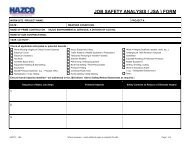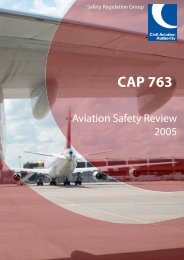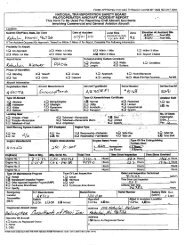International Helicopter Safety Team Safety Management System Toolkit
IHST - Safety Management Toolkit - Skybrary
IHST - Safety Management Toolkit - Skybrary
- No tags were found...
Create successful ePaper yourself
Turn your PDF publications into a flip-book with our unique Google optimized e-Paper software.
Controls<br />
Organizational process controls are typically<br />
defined in terms of special procedures, supervisory<br />
and management practices, and processes. Many<br />
controls are inherent features of the SMS framework.<br />
Such practices as continuous monitoring, internal<br />
audits, internal evaluations and management reviews<br />
are all part of the safety assurance component. They<br />
are identified as controls within the design expectations.<br />
Additionally, other practices such as documentation,<br />
process review and data tracking are identified<br />
within specific elements and processes.<br />
Interfaces<br />
This aspect includes examining such things as lines<br />
of authority between departments, lines of communication<br />
between employees, consistency of procedures<br />
and clearly delineating lines of responsibility between<br />
organizations, work units and employees. Interfaces<br />
are the “Inputs” and “Outputs” of a process.<br />
Process Measures<br />
A basic principle of safety management is fundamental<br />
processes are measured so that management<br />
can be data-driven. Outputs of each process should,<br />
therefore, be identified for assurance. For example,<br />
these outputs should be the subject of continuous monitoring,<br />
internal audits and internal evaluation.<br />
Duty<br />
Duty is something a person ought to do. It is a<br />
moral, ethical obligation to act. For example, all<br />
employees have the duty to report unsafe conditions.<br />
To be effective, a single method of reporting should<br />
be established to ensure information is effectively<br />
managed. Every person’s duties are identified and<br />
the methods they use to execute those duties are<br />
described.<br />
Duties apply to persons at every level of an organization.<br />
Some may have long-term safety impact such<br />
as the duty of mechanics to accurately maintain<br />
aircraft records. Some duties are immediate, such as<br />
a medical technician’s duty to waive off a landing due<br />
to an unsafe condition on a landing pad. Some duties<br />
are described at a higher level, i.e., management’s<br />
duty to maintain a safe workplace. And, that duty is<br />
tied to their responsibilities and authority.<br />
LEADERSHIP<br />
“The hardest thing to do<br />
and the right thing to do<br />
are often the same thing.”<br />
Organizations train personnel in their duties<br />
and authority. The duties and authorities are<br />
spelled out in a short position description. The<br />
oversight may simply occur through day-to-day<br />
contact and could include on-site training. The<br />
goal is to build an SMS that has well balanced<br />
duties, responsibilities and authorities.<br />
<strong>Safety</strong> Goals<br />
Goal-setting is vital to an organization’s performance.<br />
All organizations have their own ways of<br />
setting and expressing a vision. The vision is<br />
supported by goals and objectives. The most common<br />
weakness in setting goals is identifying outcomes,<br />
which usually means counting accidents. But, safe<br />
organizations can have accidents, while less safe<br />
organizations can be lucky and avoid accidents.<br />
Although the ultimate goal is no accidents, there are<br />
more precise and useful ways of measuring safety,<br />
especially in a safety system, than counting accidents.<br />
In some organizations, the goals are not stated<br />
very explicitly. Other organizations set goals formally<br />
and document the process. Regardless of how<br />
management goals are set, few organizations are<br />
good at developing safety goals.<br />
It is a never-ending struggle to identify and eliminate<br />
or control hazards. We will never run out of<br />
things to do to make the system safer. Sound<br />
management requires that we identify goals,<br />
decide how to achieve them, and hold ourselves<br />
accountable for achieving them. Risk management<br />
procedures can help managers decide where the<br />
greatest risks are and help to set priorities. Sound<br />
safety goal-setting concentrates on identifying<br />
systemic weaknesses as accident precursors; either<br />
eliminating or mitigating them.<br />
10 SMS <strong>Toolkit</strong>







